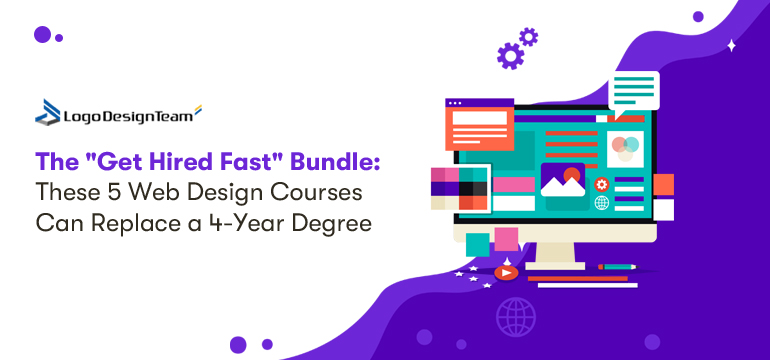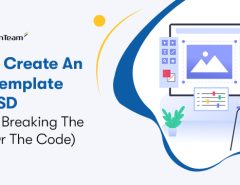The top five web design courses discussed in this article teach the skills you need to start a career without a four-year degree. They focus on practical training that helps you get hired quickly.
Why are so many people choosing web design courses over traditional four-year degree programs? Today, employers care more about skills than formal degrees, especially in the tech industry. Companies are looking for candidates who can create real projects. They want individuals who can prove their abilities and deliver results. This is what makes web design courses a high-paying career path.
If you enjoy learning and creating, web design offers a faster path to a rewarding career. Instead of spending four years in college, you can complete a few focused web design courses that teach the practical skills employers want. In this article, we explain why a traditional degree is no longer required and highlight five web design courses that can help you land a job quickly.

Summary Insights:
- You can build a full-time web design career without a conventional degree by taking structured, skill-based online courses.
- Web design courses such as the Google UX Design Certificate and freeCodeCamp teach the real-world, job-ready skills.
- Each web design course focuses on hands-on projects, so you graduate with a complete portfolio, not just theory.
- These web design courses are affordable and beginner-friendly, making them ideal for rapid career transitions.
- Employers value the project experience and portfolios more than degrees because the real skills open real opportunities.
Why You Don’t Need a 4-Year Degree to Become a Web Designer
Success in web design doesn’t demand a college diploma. With the right skills and focus, web design courses can fast-track your career without the long wait of a 4-year degree.
1: The Shift from Degrees to Demonstrable Skills
Once upon a time, having a four-year degree was the only way to prove you were qualified for a job. At that time, employers often saw a degree as the main pathway to opportunity. But now the situation has totally changed. Today, the tech industry values skills over education.
Web design courses combine creativity and user experience, making your skills more valuable than your 4-year degree. A LinkedIn Learning report found that over 89% percent of hiring managers now prioritise skills and portfolio work over formal education when hiring for tech roles. Many students hire a UK-based assignment writing service to save time and focus on building practical skills. By getting help from professionals, they invest more energy into learning real-world tools and building a strong portfolio that employers actually notice.
2: Online Learning Platforms Bridge the Gap
Online learning platforms change the way we learn skills for real jobs. Web design courses such as MOOCs and online certificates now focus on what actually helps you to get a job. Instead of spending years on a long-term degree, you learn the tools that matter most, such as HTML and UI/UX design. These platforms help you to learn about how to build websites and use the same software professionals use every day.
5 Web Design Courses That Help You Get Hired Fast
Here are five strongly recommended web design courses that will help you build responsive designs and strong portfolios. If you complete them, you’ll be in an excellent position to get a good job in the future.
1. Google UX Design Professional Certificate (via Coursera)
The Google UX Design Professional Certificate offered through Coursera is considered one of the most trusted entry-level programmes. This web design course is highly suitable for those who want to step into the world of UX design without a traditional degree.
Google experts develop the Google UX Design Professional Certificate. It walks you through the entire design process, including understanding users and testing designs through real-world projects. It’s a ticket for a journey from zero experience to professional competency.
What Will You Learn?
- Learn the foundations of UX and user-centred design thinking
- Master UX research methods
- Design wireframes and interactive interfaces
- Build a professional UX portfolio
Career Edge:
Learning from this web design course helps you to recognise credentials from Google, which holds strong authority among employers. It refers to the fact that you have learnt through structured training with real projects.
Research Insight:
According to a Burning Glass Institute report, most employers consider online professional certificates, such as Google’s UX Design Certificate, valid indicators of job readiness. It means that your certificate not only enhances your resume but also improves your employment prospects in the UX field.
According to Linda C., a web technology expert and a professional assignment writer at The Academic Papers UK,
“The growing demand for web designers has shifted the focus from academic qualifications to hands-on expertise.”
She explains,
“Most students I guide today are achieving faster success by taking web design courses that emphasise real-world projects rather than theory. Employers now want proof of skills, not degrees. When learners use online web design training in their profession, they save time and truly impress recruiters.”
2. The Web Developer Bootcamp by Colt Steele (via Udemy)
Well-known trainer Colt Steele has created Udemy Web Developer Bootcamp. This is one of the most popular and beginner-friendly web development courses. Its design is based on a coding bootcamp, which helps you go from zero experience to building a functional website. This web design course covers the full range of modern web technologies, such as HTML5 and Node.js.
What Will You Learn?
- Learn HTML and JavaScript from scratch
- Work on real-world projects and applications
Why It Replaces a Degree (for Web Development):
- This only focuses on the skills which employers want
- Promotes hands-on learning through projects instead of theory-based lectures.
- It is Faster and more affordable than a traditional 4-year degree
CourseReport found that 79% of coding bootcamp graduates land tech jobs within six months of completing their programme.
3. Responsive Web Design Certification by freeCodeCamp
The Responsive Web Design Certification from freeCodeCamp is completely free. It is a beginner-friendly course designed to teach the essentials of front-end web design. FreeCodeCamp helps learners to gain real coding skills without paying a single penny. The web design programme is based on HTML and responsive layouts.
What You’ll Learn?
- Here you will learn to build web pages.
- You also learn to use modern CSS techniques
Why It Replaces a Degree?
- The web design course focuses on the learning of practical skills.
- This design course is totally free, allowing you to learn without financial pressure or student debt.
4. Front-End Frameworks and Design Tools
It is necessary to include a web design course that covers modern front-end frameworks such as Figma and Adobe XD. In this web design course, you should also learn about version control and deployment workflows to understand how real projects move from code to live websites. These web design courses are helping you work smoothly in teams and handle real-world projects.
Why This Matters?
- Most web design jobs are based on skills beyond static pages
- Learning design tools enhances the ability to collaborate with UX/UI designers
- Understanding Git and its installation shows employers that you can manage the full project workflow.
Tip:
Pick a well-evaluated and updated course that includes real-world projects and leads you through building a complete app. If you are presently balancing homework deadlines, get connected with the most trusted assignment writing services in London to manage your academic load while focusing on practical learning. With this balance, you can make the most of the course and create a strong final project in your web design journey.
5. Portfolio And Job Readiness Workshop
Strong technical skills are most important for your bright future, but what matters most is how you showcase them. This section covers creating a personal portfolio website and preparing for interviews. At this stage, you will be able to learn how to explain your work clearly and communicate with employers who value your creativity and problem-solving skills.
What to Include?
- A portfolio website based on 3 to 5 real projects.
- Case studies of web design courses explaining each project deeply
- A GitHub profile with a clean and live demo connection for employers to explore.
- A job search plan that helps you to apply strategically with companies to tailor your applications.
LinkedIn Learning found that 72% of hiring managers prefer candidates with strong portfolios and practical project experience over academic degrees.
Final Words
The Get Hired Fast Bundle makes sure that you won’t need a four-year degree to launch a great career in web design. Every web design course focuses on real skills that employers want, such as UX design and responsive layouts.
You learn by working, not just observing. From the Google UX Design Certificate to freeCodeCamp’s responsive web design course, each of these web design programmes helps you gain confidence and job readiness one step at a time. They are flexible and affordable designs for beginners. At the end of learning these web design courses, you have a portfolio and real
Frequently Asked Questions About Web Design Courses
How Can I Become a Certified Web Designer Through Courses?
You can earn a certified web designer certification from online courses that focus on actionable and job-ready skills. At this stage, platforms such as Courses and freeCodeCamp come in practical. Some of these platforms even provide structured web design programmes that start at the basic level.
Take guidance about how to design and build a real project-based coursework writing. You can earn a verified certificate by completing all modules and tests. These certificates can help you demonstrate to employers that you have actual skills and hands-on experience.
Which Platform Offers the Most Comprehensive Web Design Training?
Some of the most comprehensive web design courses are available through Coursera. Its Google UX Design Professional Certificate and the attendant courses go into great depth on both design and user experience. You will learn it all, from design thinking to prototyping and creating a professional portfolio.
The classes cater to beginners and integrate practical projects. It also has the backing of Coursera’s partners, such as Google and Meta, which lends a level of credibility to the certificates that would benefit anyone hoping to make their fortune in web design.
What Skills Are Taught in Web Design Classes?
Web design classes cover all of the essentials to produce professional websites. You use HTML, CSS, and JavaScript to understand how websites are made. After that, you study UX and UI design, responsive layouts and accessibility to ensure sites are user-friendly.
Several courses also use tools such as Figma and GitHub to support design and collaboration. You put your skills to work in actual projects that build creativity and attention to detail. All of the courses help you become more confident and professional as a web designer.




